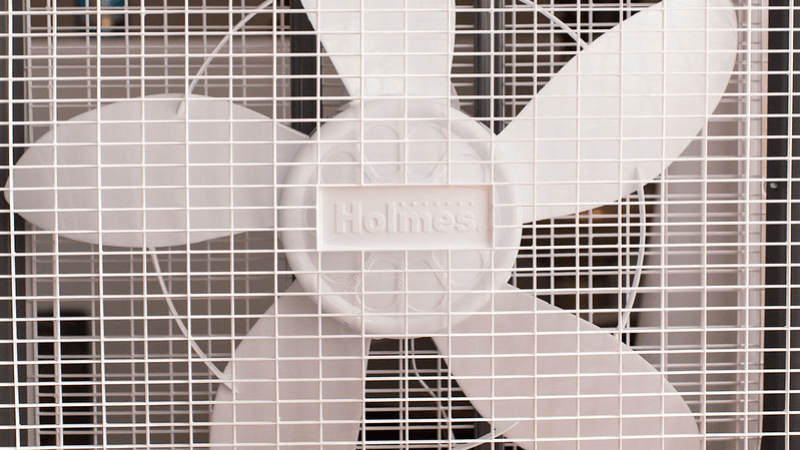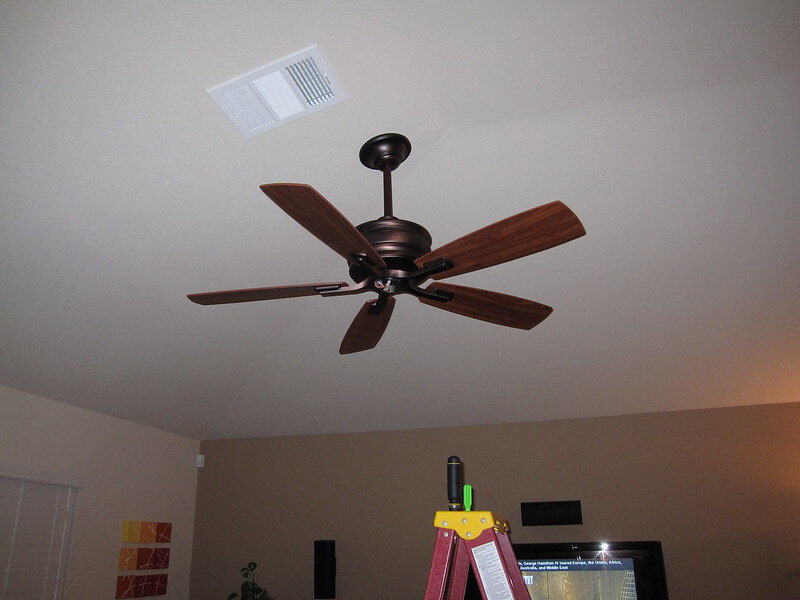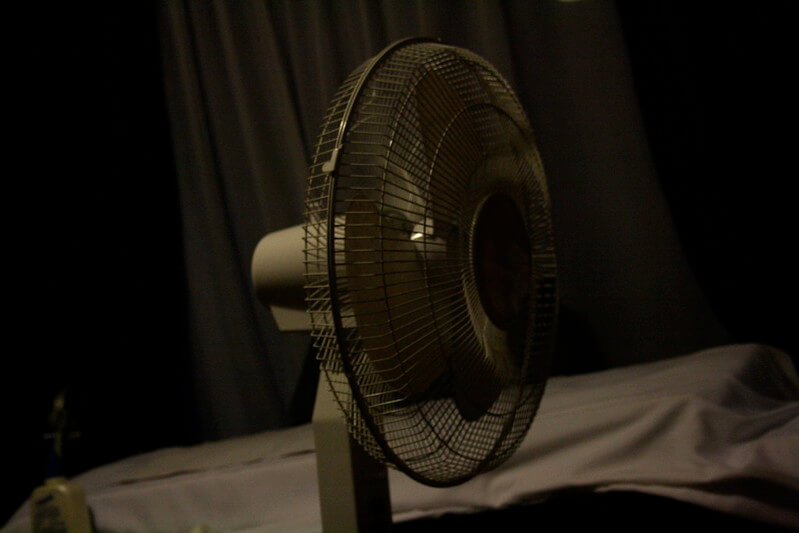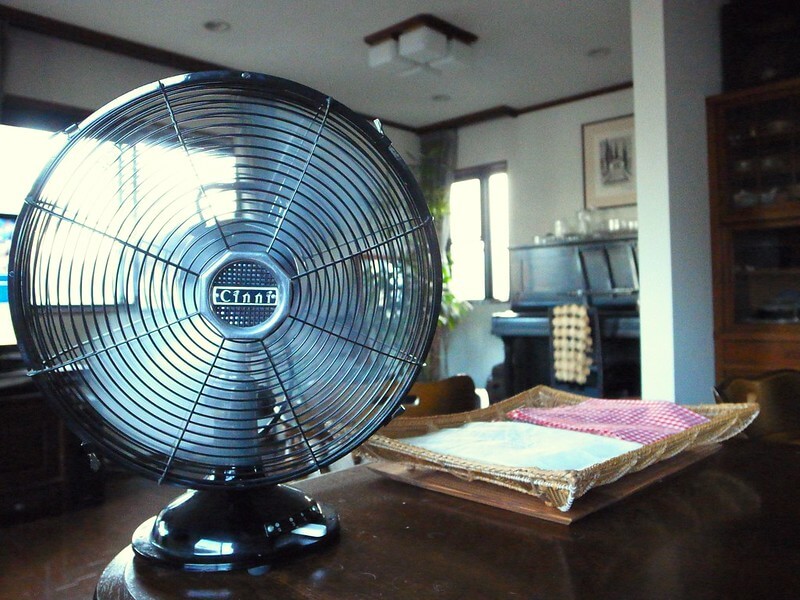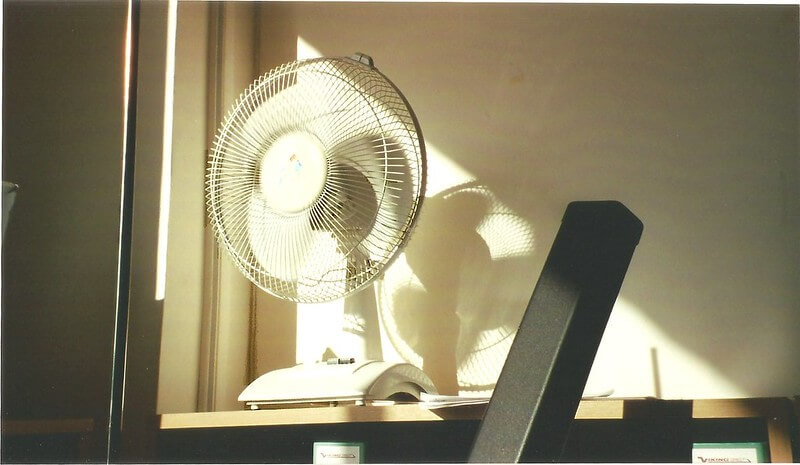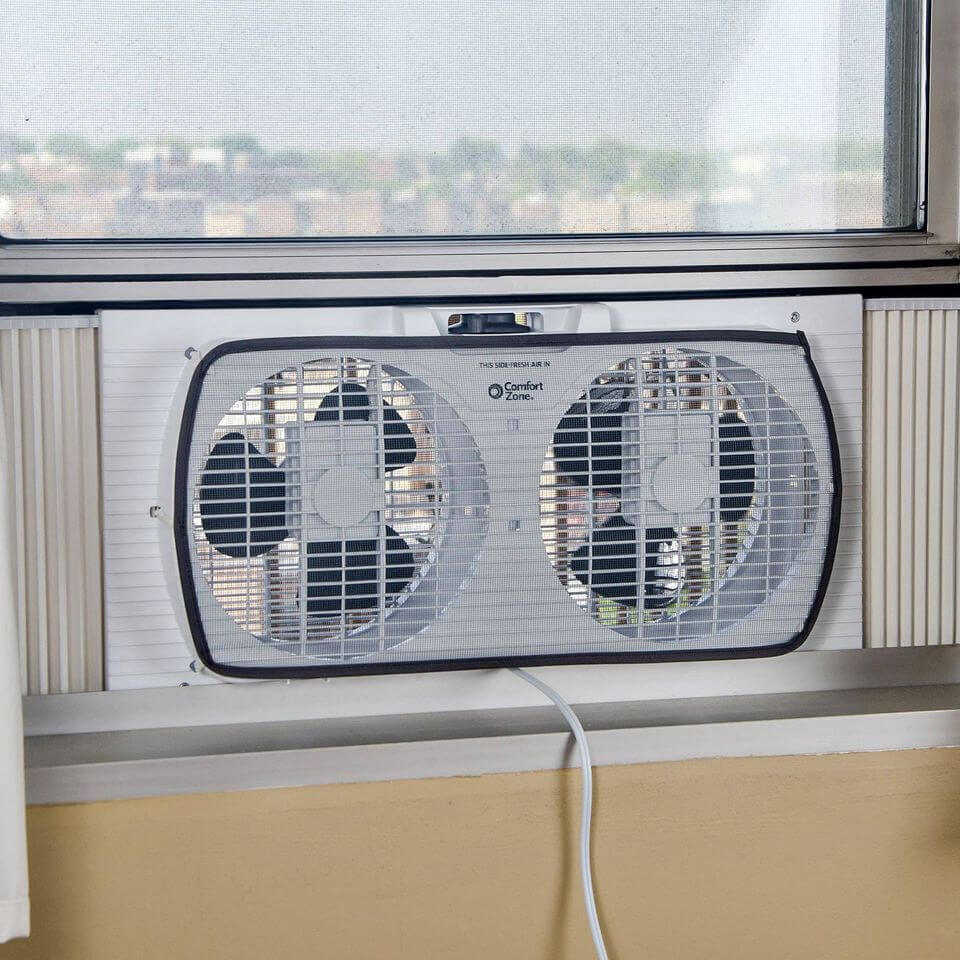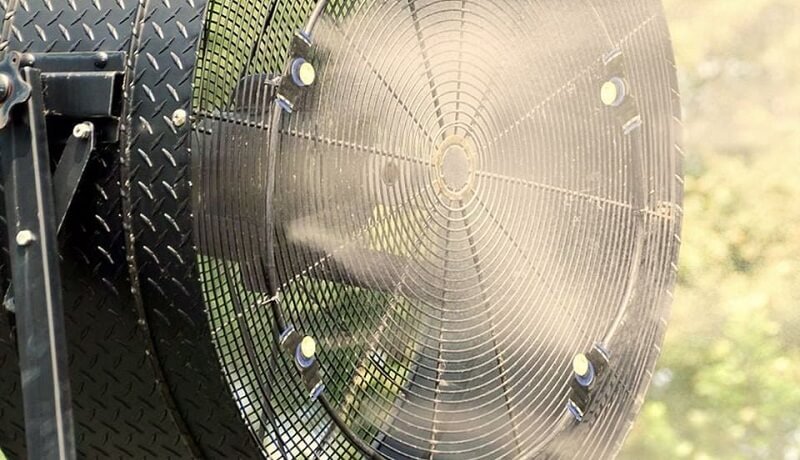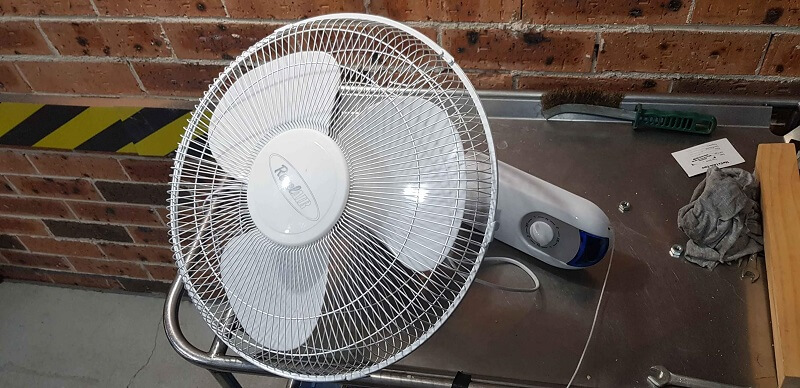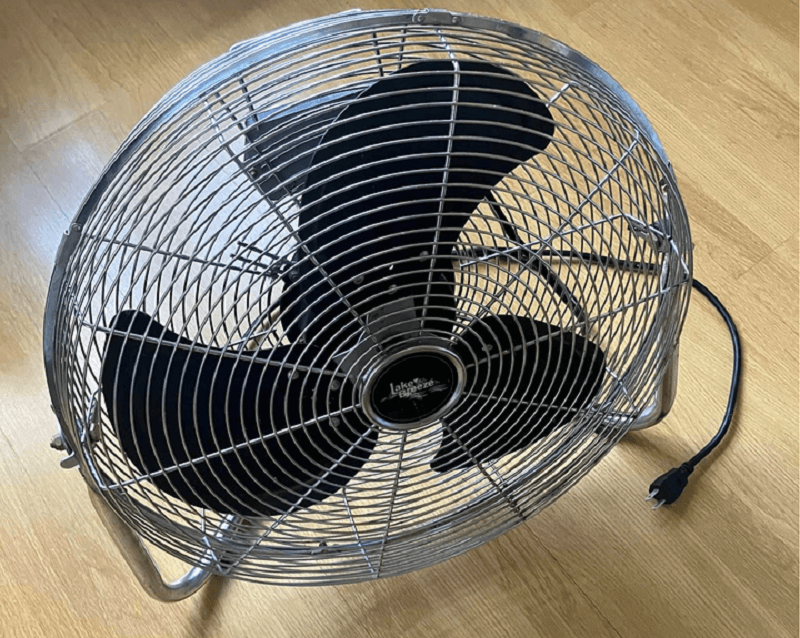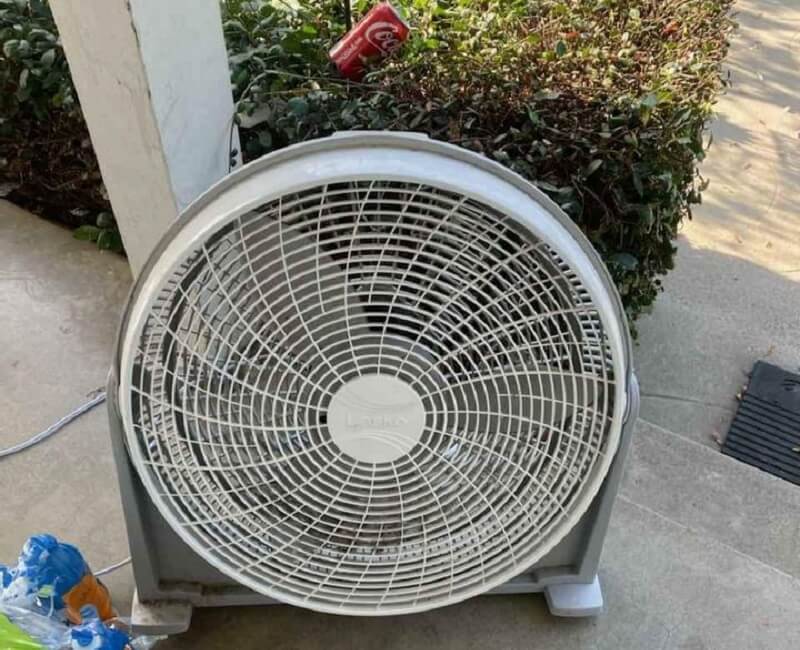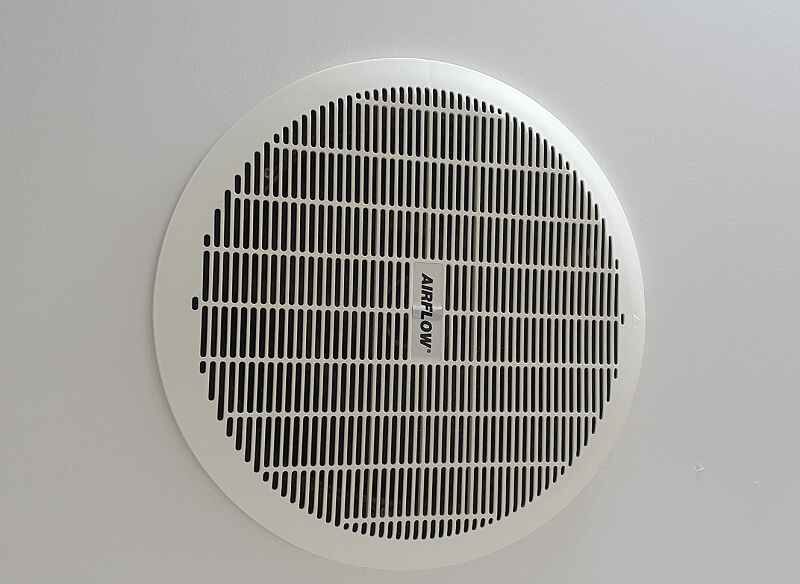Household fans are a great way to keep your home and yourself cool when the warmer times of the year come along. Unlike other home cooling methods, they are cheaper to buy and maintain and work well in different situations.
There are different types of fans you can use in your home. Each type of fan is best suited for various applications. In this post, I break down the different types of fans in our homes.
1. Ceiling Fans
Approximate Power Consumption: 50-80 watts
Common Features: Ceiling fan as a lighting fixture, remote controls,
PROS: Keeps the air in your home moving, enhances the decor of a room, and can be installed outdoors
CONS: Can be noisy, cannot be installed in a room that has a low height clearance
The ceiling fan is one of the popular types of fans in homes. As their name suggests, ceiling fans are installed or suspended from the ceiling of a home.
Most ceiling fans consist of four parts. The first is the canopy, which balances the ceiling fan, houses the wires, and holds the down rod. The down rod holds the lower part of the ceiling fan and also keeps it a little lower from the ceiling.
The housing covers the motor and protects it from dust or water. The blades, usually three or more, move the air.
The number of blades in a ceiling fan is not only one of the aesthetics and personal preferences but also affects performance. As the number of blades in a ceiling fan increases, the fans tend to be quieter, but the effect is that they circulate less air.
Having more blades slows the ceiling fan down by increasing drag. A ceiling fan with fewer blades is a good pick to move more air. However, in effect, the noise level will be a little higher. Most industrial fans only feature a maximum of two to three blades.
This means they can go faster and move more air. However, with evolving technology, ceiling fans with more blades have also grown to work better by having better design, pitch, and low-drag blades.
Aside from looking at the number of blades in a ceiling fan, there are other features that you check. Do you need a remote-controlled ceiling fan – handheld, wall, or both? There are also ceiling fans with light or chandeliers, while others might even include heaters or dual motors.
[snippet]
How many blades should a fan have?
Most fans mostly have three blades. If a fan has fewer blades, there is less drag on the motor, thus moving more air around a room. Less drag also means the fan will consume less electricity. The size of the blade also matters. Wide long blades will generate more airflow than short and narrow blades.
[/snippet]
Ceiling fans can be used indoors, or they can also be used safely in outdoor areas such as patios. However, not all fans are well made to handle the outdoor environment.
Before buying a ceiling fan, always look out for its UL Rating. The UL Rating defines the conditions a fan can tolerate. There are three UL Ratings in fans – Dry rated, Damp-rated, and Wet rated. Dry-rated fans are meant to be used indoors.
Damp-rated can handle moisture but break when exposed to direct contact with water. This type of fan is good for use in covered outdoor areas. Lastly, wet-rated ceiling fans are weather resistant and will work well in any condition, whether snow, rain or other factors.
Ceiling fans can both help in cooling and heating a room. Both forward (counter-clockwise) and reverse (clockwise) ceiling fan spinning directions affect your home’s temperature.
When you need the ceiling fan to cool your home down in summer, the blades should rotate counter-clockwise. This forces the air in the room to circulate, making it feel cooler. In the winter period, the blades should rotate clockwise. This forces the air trapped on top to come down, giving the room a warm effect.
Before buying a ceiling fan, it is essential to note the size of the area you are cooling down to select the proper size in terms of length and height of the ceiling fan.
The appropriate location should also be considered to get the maximum benefits of a ceiling fan. Selecting the right features should also make the ceiling fan easier and more efficient.
2. Tower Fans
Approximate Power Consumption: 48-100 watts
Common Features: Different speed settings, remote control, air filtration system, timer
PROS: They are quiet, portable, bladeless fan option, compact design, and safe to use around pets and children.
CONS: It might be difficult to clean
.
Tower fans, based on their physical appearance, are narrow and tall. Tower fans are one of the most popular fans in today’s homes. This is because they offer many distinct features in a very small, lightweight, and compact unit. They are very portable and also powerful in cooling down a home.

Tower fans work by sucking air from home and pushing it out through the long vents that run along with the fan’s height. Impeller blades are near the bottom of a tower’s fan cylindrical housing.
The impeller fan sucks air and focuses it on the narrow tower casing. In the casing, the air is narrow and focused. The impeller fan also helps push the air out at a 90-degree angle through the vertical shaft to the air guide and finally exits through the vents.
There are several essential features you can find in tower fans. Check for variable speed settings that allow you to select the different speed modes for optimum efficiency and convenience.
[snippet]
Are DC fans better than AC fans?
Choosing between AC and DC fans will depend on your budget, functionality, and aesthetics. DC fans are generally quieter, use less energy than AC fans, and are also faster, and DC motors are lighter and compact, allowing for a better design. AC fans are cheaper but might consume more energy than DC fans.
[/snippet]
A tower fan with remote control will also allow you to control it in the comfort of your seat. A model with an in-built timer is good for saving energy and switching off or on after a period.
Make sure the fan’s controls are easy to understand. Apart from the basic features, you can choose a tower fan with an ionizer or air filters to clean the air.
Apart from the common tower fans, bladeless tower fans are also gaining popularity in the market. A Bladeless fan like the Dyson Cool AM07 is quieter, safer, more powerful, and more power-efficient. Bladeless fans combine different technologies to work better.
Though they are called bladeless fans, they have a fan at the bottom of the unit that sucks air and directs it to the top hoop-like tube, which is expelled into your home.
Bladeless fans like the Dyson Cool AM07 use a technology known as ‘Air Multiplier’ that generates a very powerful airflow stream. When air flows into the circular hoop-like tube, it is pushed out at very high pressure.

This results in the surrounding air being drawn into the hoop for a stronger airflow 15-times more powerful than a regular fan.
Tower fans are compact and work very well to cool down a room. Most come with basic features that get the job done right. However, by digging deeper into your pocket, you can get the best of tower fans with many features.
To get the most out of a tower fan, list the features you need and select the closest model you can find in the market.
3. Pedestal Fans
Approximate Power Consumption: 50-55 watts
Common Features: Variable speed settings, timer, adjustable stand, multi-directional oscillation, tilting head
PROS: Portable, provides height adjustment, powerful, easy to clean, and easy to operate.
CONS: It can be dangerous around kids and pets if the grills are large
.
Pedestal fans are also called standing fans, and they offer one of the most common and fastest methods of cooling down a home. This type of fan is an oscillating fan.
Pedestal fan designs include an adjustable metal stand where the fan can be set up anywhere between 2 feet or more. The stand also holds the fan head, usually a fan inside a metal housing that protects a user from accidentally touching the blades. The blades can vary from two or more.
Pedestal fans are great because the height can be adjusted, and they are very portable, unlike ceiling fans or tower fans. If you want air flowing in a specific direction, change the fan.
The fan can also be adjusted if you want air to flow above your bed. Other than that, some pedestal fans will have the ability to oscillate and cool a whole room.
With growing technology, pedestal fans have also not been left behind. Modern pedestal fans include features like remote control, various speed settings, better height adjustment, tilting head, or multi-directional oscillation. However, unlike tower fans, pedestal fans are not packed with many features.
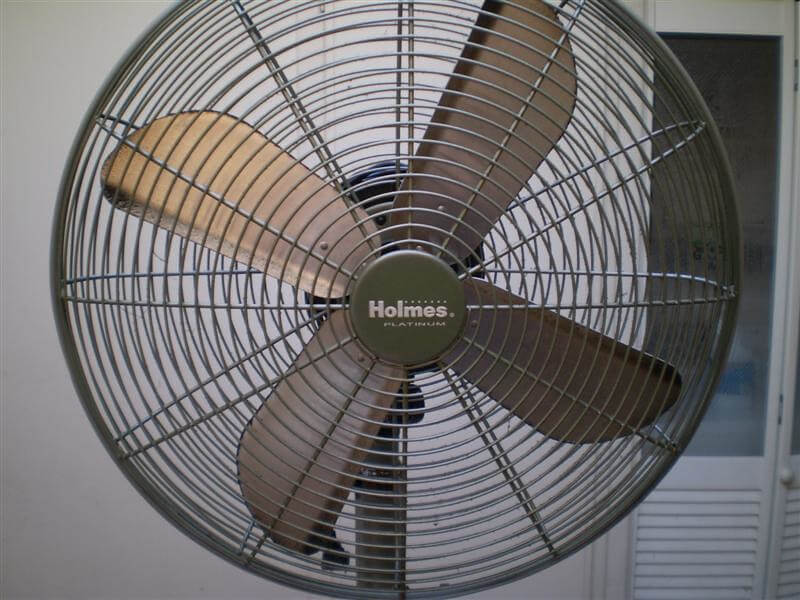
Pedestal fans are great if your home has less space or if you want to blow cool air over obstacles such as your bed or furniture in your home. Because they are adjustable, you can properly set the height for the fan to blow over obstacles.
Most pedestal fans are relatively cheap, and you can get one packed with many features at a low price. Apart from features and price, check other things like how quiet the fan will be when in operation and the size that will effectively cool down your home.
The Lasko FBA 2521 is an excellent cheap option, while the Honeywell Double Blade 16″ Pedestal Fan is a more economical option packed with features.
4. Desk/Table Fans
Approximate Power Consumption: 10-25 watts
Common Features: Tilting options, oscillation option
PROS: Portable and lightweight, cheap to buy, easy to maintain
CONS: Cannot cool a larger area
Desk fans or table fans are small and very portable types of fans. Because of their size, they can sit in flat places like desks without causing too much clutter.
The design of desk fans ranges from small pedestal styles to small tower designs and many other shapes. However, many have simple designs with a small fan, a casing that protects your fingers, and a stand to help them sit upright on a desk.
Desk fans are great for individual use. They can effectively keep a single user cool. You can use a desk fan at home when working or get one to use when studying.
[snippet]
What is the type of fans used in HVAC?
HVAC fans come in a variety of shapes and sizes. The three main types of fans used in HVAC systems are axial fans, forward-curved centrifugal fans, and backward-inclined fans. Axial fans are also known as propeller fans.
[/snippet]
You can also add one to your dressing or makeup desk. Desk fans are also very portable, and you can carry one when camping or when participating in any outdoor activity on a hot day to help you cool off.
With desk fans, you get a lot of options in style, size, and functions. However, when selecting a desk fan, I would advise someone to ensure they are lightweight and feature a long power cord, though they are not necessary.
If a desk fan is light in weight, you can easily move it around, reposition it, and in case of an accident, there will be less damage. A long cord is convenient because you do not have to worry about your desk being far from the mains power plug or in case you move your desk. Also, because this type of fan will be closely positioned near you, noise should be an important consideration
.
Apart from my tips on selecting a good desk fan, it is also better to get one that fits your taste; what everybody praises as the best might differ from what you like. You can select a desk fan in different shapes, and styles, as long as they fit your preferences and do their work effectively.
5. Window Fans
Approximate Power Consumption: 35-100 watts
Common Features: Reversible motor, remote control, water resistance, thermostat, independent fan control, adjustable extender screen
PROS: Blow in cool air and exhaust stale hot air; no need for additional space,
CONS: Can blow dust, smoke, or other odors from the environment.
As the name suggests, window fans are mounted on a window frame or wall in your home. Most fans push air around a room to create a cooling breeze.
However, window fans offer the advantage of cooling and also replacing air at the same time. They also replace stale air inside with fresh air as it pushes air into a room.
The design and size of window fans are different. There are larger models than can move and expel more air, and there are also window fans with one large fan or two fans, known as twin window fans.
If you have a choice of size, always choose the largest that can fit in your windows. If it is difficult to find a window fan that fits your particular window, you can always opt for a window fan with an adjustable extender screen.
Prime placement and the number of windows fans will also affect how they cool down your home. The more window fans you have installed, the better they work. However, you should aim to set up an equal number of window fans blowing in and blowing out.
The position of the window fan is also a determinant of how effective they work. To cool your home faster, always set up a window fan on the shady side of your home. If you have a multi-story home, set up the ground-level fans to pull in the air while the upper-level fans should exhaust rising warm air.
Window fans come with several features that help in improving their effectiveness and ease of use. Independent fan control, which features mostly twin window fans, allows independently controlling each fan for better efficiency.
When one fan pulls in fresh cool air, the other will be exhausting stale how air. Other features include an adjustable extender screen that lets you fit the fan in case it does not fit correctly, a thermostat, a reversible motor, and water resistance.
6. Misting Fans
Approximate Power Consumption: Unknown
Common Features: Remote control, water purifying, variable speed settings,
PROS: It can humidify your home, good for patio and other outdoor cooling needs, the cool mist is soothing to the skin
CONS: Does not work well in humid environments
Misting fans are like regular fans; however, they are built with water jets that produce fine mist at regular intervals. Misting fans combine a powerful fan with a high-pressure water pump.
Water is blown at high pressure via the water pumps, passing through misting nozzles and breaking down into tiny droplets. The mist produced is fine, so you don’t have to worry about wetting your clothes or skin.
For indoor use, misting fans include water tanks that users can refill before using the fan. In outdoor cases, a misting fan might include a water tank or connector where you can connect a garden hose.
In a commercial setting, you can get misting fans that sit in water storage systems or buckets, making them more portable as they do not need to be connected to a hose. The water in a misting fan is usually filtered to remove impurities before pumping it out.
Cooling misting fans use evaporation technology like an evaporative air conditioner or swamp cooler. When the fine water droplets are released into the air, they pull heat energy with them, which drops the temperature and gives a cooling effect.
Many people worry about misting fans, getting them wet, or surfaces in their homes. However, you should know that misting fans produce a fine mist that evaporates when it touches a surface.
However, the mist can build up on cold surfaces or if you are very close to the misting fan. Misting fans are great for indoor use on hot days, and you can use them outdoors to cool off on your patio or near the pool.
Though misting fans are good, their application does not effectively work in some places and conditions. If you live in an area with high humidity or are working to reduce your home’s humidity, selecting another type of fan is better.
Misting fans work great in hot and dry areas. This is because hot and dry air can hold so much water—the drier and hotter the air, the better the results of a misting fan.
7. Wall-Mounted Fans
Approximate Power Consumption: 45-60 watts
Common Features: Multi-oscillation direction, remote control, multiple speed setting
PROS: Good for small spaces, can be used anywhere, easy to install, portable.
CONS: It might not work well in a large area.
If you have less space in your home or the floor space is too small to fit a ceiling fan, then a wall-mounted fan is a way to go. Wall-mounted fans offer an alternative location for placing a fan compared to other types of fans in homes. They are designed for compact spaces with low or very high ceilings.
Wall-mounted fans’ design and style mostly resemble pedestal fans. They have a fan, which mostly features three blades covered by a metal mesh. The housing of the fan is mounted on a short stand.
The stand is the part that is mounted on the wall. Depending on the type of stand, the fan can blow cold air up to 360 degrees, making them great for moving air around a room.
The working mechanism of wall-mounted fans is different from ceiling and pedestal fans. Ceiling fans in the summer help circulate air throughout a room. In winter, they can redistribute warm air trapped above and warm up a room.
Wall-mounted fans tend to work differently. Instead of pushing air down, they push air horizontally in a room. Depending on the size and placement, you might not even feel the air being circulated.
You can consider a few things before choosing a wall-mounted fan for your home. The first is the size of the fan. Make sure you select a fan based on the space you want to cool down. Also, ensure to position the fan in a place where it will provide adequate airflow.

The speed of the fan will also vary from one model to another. Select a fan with different speed settings and see which speed will work for your home. Apart from size and speed, check for other features like the color and finish and the control type – rotary, wall, or remote.
Once you have selected your wall-mounted fan, installing one is simple because most come with brackets and mounting equipment already included. Different fans will have different instructions on how to mount them.
The height will depend on various factors. However, in most cases, wall-mounted fans must be at least five feet above the floor, or others might suggest it to be some distance below the ceiling. Always check the instructions or consult a professional to ensure the fan is correctly installed for efficient use.
8. Floor Fans
Approximate Power Consumption: 40-100 watts
Common Features: Remote control, oscillating head
PROS: powerful, simple, and minimalistic design
CONS: Will not work in a cramped up space
A floor fan is a great and fast way to get your home cool in no time. Floor fans, as the name suggests, are placed on the floor. They are simple in design, often just having the base support and the fan in a metal mesh housing. However, this type of fan is very powerful and capable of generating serious airflow around a room.
Floor fans are simply designed. It will be a long search if you plan to buy one to compliment your decor. Most will feature a hollow metal stand that supports the housing unit and keeps the fan stable.
Though the styling is mostly the same throughout different brands, the size will differ. There are small fans that can be utilized in homes and also large industrial-grade floor fans.
Apart from the size, there are several other features you can look for when purchasing a floor fan. First, check if the fan is noisy. Floor fans are powerful, and this, in effect, will produce noise. Always run the fan in different speed settings and see if they are tolerable and quiet for your needs.
Second, check for safety if you have kids or pets around your home. Make sure the housing grille is secure. Check that your pet or kids will not be able to put in any part of their body that may end up causing an accident. The fan should also have a stable base to avoid flipping easily.
While floor fans are designed to focus air to one point, some options allow the fan to circulate and provide airflow to every corner of a room. The head movement feature also adjusts the fan’s angle to your preferences. If you are using a floor fan mainly at home and not for industrial purposes, it is unnecessary to get a floor fan with a 100 percent flexible head.
9. Exhaust Fans
Approximate Power Consumption: 50-60 watts
Common Features: Timer, lighting, heat lamp,
PROS: Help remove excess moisture, remove smoke and odors
CONS: It might require professional installation
Exhaust fans in homes are important in keeping the temperature ideal and improving air quality. Mostly, exhaust fans are used to remove excess moisture and odors in a room. Exhaust fans are commonly found in the bathroom, laundry area, or kitchen, where moisture is caused by washing, showering, or cooking.
Exhaust fans work by pulling fumes, moisture, or odors into a room and venting them outside. The fan comes with a powerful fan whose function is to pull air and expel it outdoors. Like most fans, exhaust fans are powered via electricity and can be controlled using a wall switch. You can also get an exhaust fan with a built-in thermostat, which signals the fan to work and maintain the ideal temperature.
[snippet]
Should windows be open when using fans?
It is better to leave windows open when using a fan. Placing the fan near the window should help draw the cooler air in. However, it is better to keep the windows shut if you live in dusty or pollen-ridden areas. Also, if the outside is hotter than your home, it is better to keep the windows closed.
[/snippet]
In homes, there are different models of exhaust fans available. These can be vented directly outside, use existing ductwork, or connect to your home’s ventilation system.
These are called ducted exhaust fans. In bathrooms, wall and ceiling-mounted exhaust fans are the ones commonly used. In kitchens, range hood exhaust fans are used. Both bathroom and range hood exhaust fans are both vented outdoors. There are also inline exhaust fans connected to a home’s ductwork to exhaust air through a home’s ventilation system.
There are also non-ducted exhaust fans that can also be used in homes. Non-ducted fans work by moving air to the roof space or attic, while other types clean the air using charcoal filters and then release it back into a room.
10. Whole House Fans
Approximate Power Consumption: 200-700 watts
Common Features: Wired & wireless controls, thermostat, various speed settings
PROS: Effective in cooling down a whole house,
CONS: It might pull in pollen. dust of other odors will not work effectively in some areas
Whole house fans serve the purpose of an exhaust system. However, unlike the exhaust fans, I mentioned above, these exhaust stale air through ventilation provided in the ceiling and pull fresh air through the open spaces like windows and doors. For whole-house fans to work optimally, a home must have open spaces that allow air inside the home.
Whole house fans work by utilizing the convection current. This is where hot air rises and cold air sinks. Whole house fans do not push air around a room like other fans; rather, they pull air. When hot air rises, a whole house fan pulls it and exhausts it. At the same time, it pulls air from the outdoors.
Though whole house fans come with their advantages, they also have demerits, making them unusable in some conditions. First, if you live in an extremely humid, pollen-laden, or dusty area, a whole house can bring these problems indoors.
This might affect your health or cause severe problems for allergy sufferers. Second, whole-house fans are effective when the outside temperature dips slightly below the desired indoor temperature. Five degrees is good, but ten or more is better.
Whole-house fans are also gaining popularity, and in some states like California, new residential and commercial buildings are required to have whole-house fans installed.
This took effect in 2014 in climate zones eight to 14, including El Toro, Pasadena, Riverside, Red Bluff, Sacramento, Fresno, and China Lake. Whole house fans have been identified as a cost-effective way to cool down an entire home.
Whole house fans should, however, not be confused with attic fans. Attic fans are installed on the gable or the roof and are only used to ventilate the attic. In summer, attic fans exhaust hot air; in winter, they help prevent condensation, mold growth, and ice damming.
[snippet]
Can you run a whole house fan all night?
Running a whole house fan all night will depend on several factors. However, I would advise someone to use it during the coolest times of the day. Running a whole house fan late in the evening should keep a home cool through the night. You can also run it early morning to keep the home cool during the day.
[/snippet]
Happy Choosing the Right Type of Fan
When buying a fan, you should consider several factors. A fan in your home should perform at the highest efficiency. The type of fan you use in your home is one of the main factors you should consider.
However, other factors include the size of the room, floor height, and the amount of air a room gets. Most of the fans look alike and with minor changes in the design or working principle to make them serve better in different situations.

